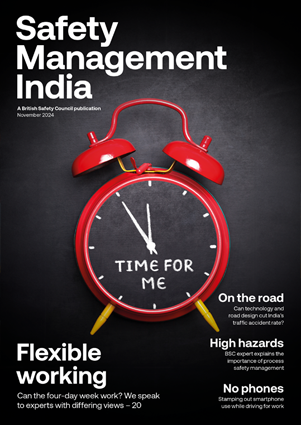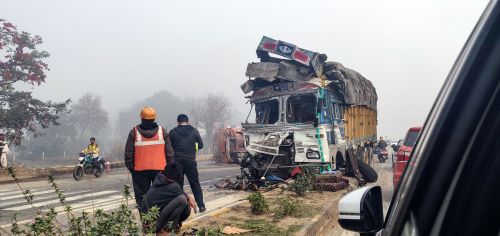Slip-resistant footwear is a vital tool in preventing slips at work, but it’s important to consider factors like wearer comfort to ensure it provides the most effective protection.
Features
Best foot forward
Slips, trips and falls are, on average, responsible for around a third of all non-fatal major injuries to employees reported by employers in Britain; and two fatalities each year. Ninety-five per cent of major slips result in broken bones, requiring a minimum of six to eight weeks to heal. While the cost to human health is incalculable, the cost to employers from lost production and other expenses has been estimated at £512 million every year.
Clearly, selecting and providing slip-resistant footwear that is most appropriate for the slip hazards, the work environment and the workers who need to wear it can play a big part in preventing slips. Also, investing in high quality protective footwear that fits well and is comfortable to wear for extended periods can provide an important boost to worker wellbeing and productivity.
 Manufacturers must prove the slip-resistant performance of footwear by carrying out tests in line with the primary safety standard, EN ISO 20345:2011. Photograph: HAIX
Manufacturers must prove the slip-resistant performance of footwear by carrying out tests in line with the primary safety standard, EN ISO 20345:2011. Photograph: HAIX
Assessing the risk of slips, trips and falls
Obstructions in walkways are the main cause of trips, with the rest being a result of uneven surfaces. The Health and Safety Executive’s (HSE’s) guidance on preventing trips suggests three main points of action. These are ensuring that:
- Floors, walkways and traffic routes are suitable for the environment, fitted correctly and properly maintained
- Walkways are kept clean and tidy and free of obstructions like trailing wires
- Employees have a ‘see it, sort it’ attitude to preventing and removing trip hazards.
The HSE calculates the risks of slips through a slip potential model3, where several factors can contribute towards the likelihood of an accident. These are:
- Contamination of an area through rainwater, oil, dust or another slippery substance
- Cleaning methods and practices, including choosing the right cleaning product, method and time
- People or human factors – employee behaviour can affect the likelihood of slips and trips; for instance, if staff prioritise safety by dealing with spillages immediately rather than leaving them for others to clean up, wear the PPE provided (such as slip-resistance footwear rather than their own footwear) and mentally assess slip and trip risks ‘as they go’
- Flooring is fit for purpose and maintained in good condition
- Environmental issues like lighting, noises that might be loud or unfamiliar, weather, humidity and condensation, which can all affect the risk of slips occurring
- Footwear – how effectively it prevents or reduces slipping risks.
 Simon Ash: "Investing in high-quality footwear can set workers on the right path to preventing slips, trips and falls at work. "
Simon Ash: "Investing in high-quality footwear can set workers on the right path to preventing slips, trips and falls at work. "
Footwear can protect workers, but not all shoes are created equal
Footwear can help protect workers from slips, but choosing the most appropriate and suitable footwear often poses hurdles. There is a huge array of footwear to choose from in the market, so being in-the-know about technical phrasing and shoe specifications is important in getting the most out of a boot and ensuring it provides the best protection against slips and any other hazards, like falling objects.
When selecting footwear, it makes sense to pay for quality, and workers will expect to be provided with quality shoes and boots. Although cheaper footwear can appear attractive from a budgeting perspective, premium high-quality footwear will in many cases provide increased comfort and performance, as well as lasting for longer even when used frequently. In fact, some suppliers who invest in quality have also started to offer boot repair services, reinforcing that investing in well-made PPE can save money in the long term, by reducing the costs of replacing it.
When selecting slip-resistance footwear, it is essential employers have a good knowledge of the working environment that the shoes will be used. This is because different materials will behave in certain ways depending on the chemicals and environments they are exposed to. For example, ‘oil-resistant’ footwear does not equal slip-resistant; this statement just means that oil will not damage the soles of the shoe. Employers should therefore identify the main surfaces and contaminants which cause slip risks in their workplace, and seek the supplier’s advice on the most suitable footwear for these conditions.
Key footwear features to look for
When choosing safety footwear, the slip-resistance it is likely to provide in the specific circumstances at work must be considered. It is therefore important to carry out a thorough risk assessment, looking at factors such as the type of contamination that is likely to occur, the types of floor surface present and information on the footwear’s slip-resistance properties provided by the manufacturer (though footwear should never be selected on the basis of laboratory test results alone).
Footwear manufacturers have developed new technology that helps to improve slip resistance, such as incorporating special heel cups to provide additional stability. Also, footwear has been developed that is capable of reducing the risk of slips in particular circumstances.
For example, shoes and boots are available that provide a more secure grip when faced with steep slopes, wet roads and oil-covered floors in workshops because the outsoles have been manufactured in a special abrasion-resistant rubber compound with a bold tread.
 Photograph: HAIX
Photograph: HAIX
However, as well as selecting footwear with the appropriate slip-resistance qualities and other safety features – like toe protection if required – it is essential footwear is trialled at work before the final purchasing decision, to ensure it meets the needs of the environment and the wearer.
Manufacturers must prove the slip-resistant performance of footwear by carrying out tests in line with the primary safety standard, EN ISO 20345:2011. Footwear that passes the EN test for slip-resistance will be marked with codes indicating it has met the specified requirements when tested for certain conditions. These are:
- SRA: tested on a ceramic tile wetted with a diluted soap solution.
- SRB: tested on smooth steel with glycerol.
- SRC: tested under both the aforementioned conditions.
It’s worth noting that European specifications are changing. In Germany, DIN EN ISO 20345 defines the requirements of safety footwear, and updates to this standard were published in June 2022. It is therefore important to check the manufacturer is meeting any new specifications for safety footwear to ensure the products remain high quality and the most appropriate slip-resistant footwear can be selected.
The importance of waterproof and breathable materials
Breathability and water resistance are two other important factors that should also be considered when selecting footwear. Wet and hot feet can be very uncomfortable, particularly for prolonged periods at work, and this can lead to a drop in concentration levels as the wearer becomes preoccupied with the comfort of their feet, rather than focusing on the task at hand. Distractions can increase the risk of accidents, so it’s important to provide waterproof and breathable footwear to reduce the risk of workers losing concentration due to feeling uncomfortable.
Waterproof boots should meet the minimum European standard, EN ISO standard: 20345/20347. Boots that utilise a Gore-Tex membrane, containing microscopic pores that are 20,000 times smaller than a water droplet, pass this standard and provide waterproofing to keep feet dry and comfortable.
To keep feet ventilated when working hard, uppers – the part of the shoe covering the top, sides, back and toes of the foot – should be made from appropriate leather or breathable material.
Consider wearer foot health
Planar fasciitis is a common concern with safety footwear. The condition causes acute heel pain due to inflammation of the plantar fascia and is common among those who are on their feet for long periods, such as factory workers. If left untreated, the condition can lead to health issues, further increasing the risk of accidents and injury.
However, using advances in design influenced by biomechanics, footwear manufacturers can address these issues. For example, incorporating a support system that supports the natural curvature of the foot, can help the wearer maintain a more natural foot position. This helps to reduce wearer fatigue, especially when boots are worn over long working periods, ensuring better overall bodily posture and acting to minimise long-term injury risk associated with standing for long periods of time.
Although workers can suffer other injuries while wearing safety footwear, such as leg fatigue due to the weight of boots, the risk can be reduced by choosing footwear that incorporates smart materials. For instance, advancements in technology and fabrics have created puncture-resistant boot midsoles that are lighter, more comfortable and more flexible compared to older metal materials. Also, nanocarbon is now being used in boots to create lightweight toe caps that meet the same standards as steel caps.
Investing in high-quality footwear can set workers on the right path to preventing slips, trips and falls at work. However, it is vital that employers fully assess and understand the slips and trip hazards and risks in their workplace, and carefully choose footwear with the most suitable slip-resistance qualities, materials and design.
For more information see: haix.co.uk
Simon Ash is UK sales manager at HAIX


FEATURES
Why changes to recycling legislation in England are an opportunity, not a burden
By on 12 November 2024

Road safety in India: could better road safety, vehicle technology and enforcement make driving for work safer?
By Orchie Bandyopadhyay on 10 November 2024
India has a poor road safety record, and research shows that commercial vehicles are a major contributor to the problem, with trucks estimated to be the single largest vehicle type involved in impacts leading to fatalities. We look at solutions that could make driving for work and the roads in general safer – from in-vehicle technology that warns truck drivers about unsafe behaviour to improving the design features of major highways.

